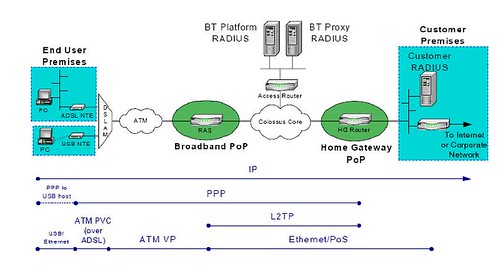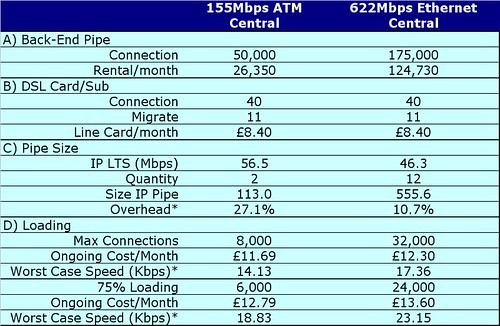UK Broadband Economics: Part I - Reseller
The great thing about BT is that the price list is in the public domain, so the average punter can examine and estimate the profits (or losses) that their ISP is making. The price list provides a clue as to why some ISPs are making a mad rush into LLU, however you need a crystal ball to explain why Vodafone are not following Orange and O2 into the battle.
Extremely simplistically, the way BT’s IPStream product functions is that an ISP effectively rents a pipe onto the BT IP Network (aka Colossus) and then asks BT to provide a connection for a specific end-user copper pair identified by a phone number and which can be shared with BT voice services. BT & the ISP configure the end-to-end connection for the pipe and then anytime “a_user@a_isp” requests a dsl connection, access is granted (aka authentication) by validating details on the ISP's (for the User) & BT’s (for the ISP) user database (aka radius).

Unfortunately, BT’s network is very much last century with inefficient ATM and L2TP tunneling featuring heavily. Fortunately, the BT network is rock solid and assuming that the ISP rents enough capacity into Collossus (aka BT Centrals) then the end-user will be extremely happy. Unfortunately, BT Centrals are extremely expensive.

All the costs above are quoted net of VAT and only represent a portion of the ISPs cost. I have excluded connection or migration costs. ISP's also have significant network, peering, IT, marketing, personnel and overhead costs.
Again simplifying, there are two type of BT Centrals either 155Mbps or 622 Mbps, with the former being the most popular and both involving huge upfront costs and financial commitments. BT have a family of products which attempt to reduce these commitments and allow for smaller ISPs to enter and transition the market.
It is interesting to note that the costs do not vary according to line card. In other words the price paid to BT is the same whether the card is configured to 1MBps, 2MBps or max 8MBps. The variable element of the equation is in the cost of BT Centrals and these are expensive: a 622Mbps link costs a mammouth £1,496,760 (ex VAT) per annum and this is where the Quality of Service of the ISPs kicks in.
ISPs are basically reliant on their users being inactive for large periods of the day. For instance, if an ISP was guaranteeing 2Mbps connectivity to 275 users at peak hour, this would cost the ISP £453/month/customer. Immediately you can see why ISPs (but not BT Wholesale) hate bandwidth hogging applications such as P2P video downloads. You can also see why some ISPs turn a blind eye to P2Pers filling the pipe in the middle of the night – “nobody is using the pipe so I don’t mind if the naughty boys fill it in the depth of the night”
However, some unscrupulous ISPs are deliberately not buying enough capacity to provide a “reasonable” service in peak hour which match their marketing “promises” and worse still are using tricks like idle time disconnects to force more connections into the pipe.
There is another problem with BT’s Central architecture and that is the L2TP overhead:

If you look at the diagram above, an IP packet sent from a typical application carries 42 bytes of L2TP overhead, which is quite substantial for short and long packets. IP configuration on most PCs set the MTU (maximum transmission unit) as 1500 bytes which means they get fragmented: most PCs using BT resale should set the MTU to 1458 bytes. This means another reduction in the size of BT Central Pipe actually dedicated to the transmission of end-user IP datagrams.
Given this and the prices that TalkTalk and Sky are quoted, it would seem an extremely foolish person not to jump on the LLU bandwagon.
However:
Ergo, the evolution of BT with the deployment of the 21CN in the next couple of years will turn the economics of last mile on its’ head.
In my opinion, the broadband wars have only just started and we are in the initial phase where the battlefield is being shaped and currently we are in a WWI trench warfare battle; BT are probably hoping on deploying a WWII 21CN nuclear device forcing the opposition to surrender; and maybe Vodafone is sat on the sidelines committing minimal resources hoping to win the peace with a Marshall-esque plan which will convert the BT 21CN into something more red, rock solid and restless.
Then again, perhaps everyone is firing random bullets in a darkened room...
Extremely simplistically, the way BT’s IPStream product functions is that an ISP effectively rents a pipe onto the BT IP Network (aka Colossus) and then asks BT to provide a connection for a specific end-user copper pair identified by a phone number and which can be shared with BT voice services. BT & the ISP configure the end-to-end connection for the pipe and then anytime “a_user@a_isp” requests a dsl connection, access is granted (aka authentication) by validating details on the ISP's (for the User) & BT’s (for the ISP) user database (aka radius).

Unfortunately, BT’s network is very much last century with inefficient ATM and L2TP tunneling featuring heavily. Fortunately, the BT network is rock solid and assuming that the ISP rents enough capacity into Collossus (aka BT Centrals) then the end-user will be extremely happy. Unfortunately, BT Centrals are extremely expensive.

All the costs above are quoted net of VAT and only represent a portion of the ISPs cost. I have excluded connection or migration costs. ISP's also have significant network, peering, IT, marketing, personnel and overhead costs.
Again simplifying, there are two type of BT Centrals either 155Mbps or 622 Mbps, with the former being the most popular and both involving huge upfront costs and financial commitments. BT have a family of products which attempt to reduce these commitments and allow for smaller ISPs to enter and transition the market.
It is interesting to note that the costs do not vary according to line card. In other words the price paid to BT is the same whether the card is configured to 1MBps, 2MBps or max 8MBps. The variable element of the equation is in the cost of BT Centrals and these are expensive: a 622Mbps link costs a mammouth £1,496,760 (ex VAT) per annum and this is where the Quality of Service of the ISPs kicks in.
ISPs are basically reliant on their users being inactive for large periods of the day. For instance, if an ISP was guaranteeing 2Mbps connectivity to 275 users at peak hour, this would cost the ISP £453/month/customer. Immediately you can see why ISPs (but not BT Wholesale) hate bandwidth hogging applications such as P2P video downloads. You can also see why some ISPs turn a blind eye to P2Pers filling the pipe in the middle of the night – “nobody is using the pipe so I don’t mind if the naughty boys fill it in the depth of the night”
However, some unscrupulous ISPs are deliberately not buying enough capacity to provide a “reasonable” service in peak hour which match their marketing “promises” and worse still are using tricks like idle time disconnects to force more connections into the pipe.
There is another problem with BT’s Central architecture and that is the L2TP overhead:

If you look at the diagram above, an IP packet sent from a typical application carries 42 bytes of L2TP overhead, which is quite substantial for short and long packets. IP configuration on most PCs set the MTU (maximum transmission unit) as 1500 bytes which means they get fragmented: most PCs using BT resale should set the MTU to 1458 bytes. This means another reduction in the size of BT Central Pipe actually dedicated to the transmission of end-user IP datagrams.
Given this and the prices that TalkTalk and Sky are quoted, it would seem an extremely foolish person not to jump on the LLU bandwagon.
However:
BT is only permitted by the UK regulator, OFCOM, to revise its’ IPStream pricing when total LLU customers reach 1.5m – given present take-up a big reduction should be on the cards within the year;
BT's 21CN network is nearly upon us. BT’s “IP over ATM” Collossus Solution is going to disappear and be replaced with something much more interesting and efficient.
BT plan to deploy ADSL2plus by Jan 2008 (to all MSANs) and thereby 99.9999% of the UK population: interconnection to a mere 100 metro-nodes will give redundant access to all 5.5k BT MSANs.
BT plan to hold network intelligence at the i-node and perhaps this is the future expensive bit (application access) rather than current expensive bit (physical access)
In my opinion, the broadband wars have only just started and we are in the initial phase where the battlefield is being shaped and currently we are in a WWI trench warfare battle; BT are probably hoping on deploying a WWII 21CN nuclear device forcing the opposition to surrender; and maybe Vodafone is sat on the sidelines committing minimal resources hoping to win the peace with a Marshall-esque plan which will convert the BT 21CN into something more red, rock solid and restless.
Then again, perhaps everyone is firing random bullets in a darkened room...




<< Home